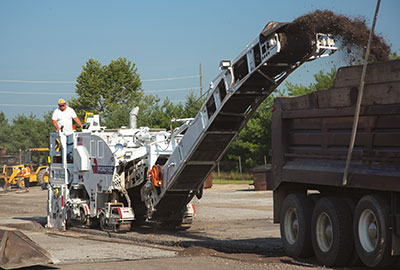
Features
Aggregates
Technology
The Right Way to Mill a Road
Knowing how to use the technology to provide the best results.
September 25, 2013 By Jeff Winke
Asphalt milling is the process of grinding up asphalt that can then be recycled.
Asphalt milling is the process of grinding up asphalt that can then be recycled. The process came about because many streets were getting layered higher and higher as new surfaces were added, thus reducing the curb height and creating roadway drainage problems.
 |
|
| Technological advancements in microelectronics have helped improve efficiency and performance in the milling process.
|
From the start, the emphasis for milling machines was to place more power to the cutting drum in order to remove more material. Thus, the cutter head itself and the cutting teeth designs became critical. The cutting teeth would dull fairly quickly and needed frequent replacement. The replacement process could cause enough downtime to greatly detract from the initial efficiency of the milling process itself. So manufacturers worked on designs for quicker replacement as well as increased durability of the cutting teeth. Different sized cutting drums were offered so that machines could mill at different widths.
Milling machines feature conveyor systems to collect the material during the milling process, thus reducing the labour of picking up the material from the roadway. Newer models require two or more people to operate safely and efficiently. The operator stands on the deck of the machine and controls most of the machine’s functions, while a worker on the ground controls the depth of the cut and keeps an eye out for obstructions in the roadway such as manholes and/or water valves.
Today’s machines are bigger and more technologically advanced. They are designed to handle any asphalt aggregates in use today. Depending on the depth of the cut, some of the larger machines can cut close to 15,000 square yards (13,000 square metres) a day, at 75 feet (22.86 metres) per minute.
In addition to faster speed, added precision to the milling process has become important. The innovation of controls and automation has brought greater precision for controlling slope, depth and speed.
There is no question that the technological advancements made in microelectronics have benefited milling machines. Electronics designed to improve performance, include electronic sensors and a built-in cross slope. A pair of sensors can read a variety of references from 12 to 55 inches directly below the bottom of the sensor. Each sensor can be calibrated and adjusted from the ground level or at the operator’s console.
The position of the rotor in relation to the grade reference can be constantly displayed on the central controller. Changes to the elevation controls include the addition of a raise/lower switch that is used when milling around obstacles. In many cases, the electronic control module monitors and regulates the performance of major machine systems, including speed, steering, rotor drive and other functions. If a problem occurs, a warning is issued.
Along with the electronic features that keep milling machines on track are the advances being made in the cutting end of the machines. The ability to change cutting drums quickly to achieve multiple cutting widths with the same machine is a benefit to contractors who may need only one machine to accomplish multiple job requirements.
Some manufacturers add flexibility to the machines by manufacturing and assembling the milling tractors and cutters separately, allowing the contractor to choose from several cutter patterns and widths when ordering equipment. The cutter assembly is designed for quick changing of cutting pattern styles and widths.
Roadtec machines also have the ability to mill in two different directions to accomplish different results. Traditional milling is accomplished in an up-cut direction. But Roadtec’s offerings also can down-cut, which is designed to control slabbing, permit pulverizing and mixing, and can be an effective way to remove material over wet base. The down-cutting feature is also designed to convert Roadtec milling machines into cold-in-place recycle machines.
Today’s milling machines also reduce the time required to change the all-important cutting teeth. Early machines had the teeth welded on, so tooth replacement required a fair amount of downtime as each had to be re-welded to the drum. Now, teeth are held in variously designed bolt-on housings that permit faster changing. Also, some machines come with an air compressor as standard equipment, allowing the use of pneumatic tools for quicker tooth changes.
A relatively recent innovation to milling has been the introduction of micromilling. A big benefit of micromilling that is shaping the future of road milling is that the micromilled surface is smooth enough for road users to travel relatively fast over the surface during construction. Contractors can open the milled surface to traffic and come back later with an overlay. Cold winter provinces especially can save the cost of patching in the fall by micromilling instead. They then can then get an early start in the spring with paving.
From its early days, the milling machine has had a dramatic impact on road construction. Ongoing improvements and innovations to the machine will continue to secure its pre-eminent role in road reconstruction.
Print this page